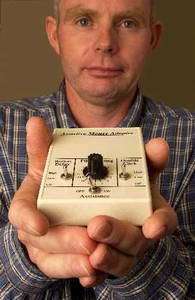Mouse adapter for hand tremor sufferers

IBM researchers invent a new assitivecomputer mouse adapter to help hand tremor sufferers use personal computers. It eliminates excessive cursor movement, thereby allowing more normal use of a personal computer. IBM is licensing the mouse adapter to Montrose Secam Limited, a small British electronics company, which plans to manufacture and sell the Assistive Mouse Adapter for under $100.
Essential tremor is a very common but complex neurologic movement disorder. It's called "essential" because in the past, it had no known cause. It shows as muscle contractions that cause rhythmic shaking and involuntary movement, usually of the hand (but may also affect other parts of the body).
According to the International Essential Tremor Foundation (IETF), nearly 10 million people in the United States alone are affected by Essential Tremor, the most common form of hand tremors. The involuntary movements of the hand when using a computer mouse make it extremely difficult to operate a PC. Simple tasks like opening an email or navigating the web are made almost impossible because of the erratic movements of the cursor on the screen.
The new mouse adapter filters out the shaking movements of the hand – in a similar way to how the image stabilizing systems of some camera lenses work. The device, which is designed to work with any PC and operating system, can benefit users in homes and offices, as well as in public places like libraries and universities. No additional software is required; the adapter is simply plugged in between the computer and the mouse and can be switched on or off, and adjusted depending on the tremor severity. It can also be set to filter out unintended multiple clicking on the mouse caused by a shaking finger.
Parkinson’s is perhaps the disease most commonly associated with tremors, but there are other conditions such as Essential Tremor (ET) which are less well known but actually more common. While tremor conditions are often worse in the elderly, they can occur in people of all ages - Essential Tremor, for example, is a condition inherited genetically at birth and can affect people throughout their lives.
“Tremor conditions can have a devastating effect on people’s lives because they make many simple everyday tasks incredibly difficult – everything from holding a drink, to buttoning a shirt,” said Catherine Rice of the International Essential Tremor Foundation. “Using a computer mouse is well known for being extremely hard for people with tremors so we’re delighted to hear that a technology has been developed to address this problem – we anticipate that it will generate a huge interest with sufferers of the condition.”
According to the World Health Organization, worldwide there are more than 750 million persons with disabilities, of which 54 million people reside in the U.S. IBM sees this market as a significant business opportunity and a way to apply technology to improve the quality of life for so many individuals. IBM believes such accessible computing technologies will eventually become accepted as mainstream by business customers.
“As technology becomes more prevalent in society, people are expected to do more with computers,” said James Levine, one of the IBM researchers who originally developed the mouse adapter. “I had seen how one of my own relatives who had a tremor condition struggled to use a computer at home - he simply could not do it. I knew that there must be way to improve the situation for him and the millions of other tremor sufferers around the world, including the elderly. Using the assistive mouse adapter, hand tremor sufferers will no longer have to rely on others to help with everyday tasks such as banking, shopping or receiving medical advice."

















